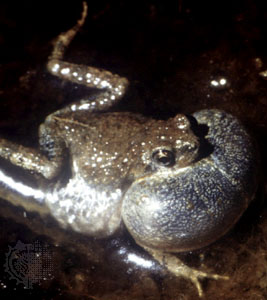Anisogamy (see figure 1), or sexual reproduction in which two different gametes fuse to produce a new individual, leads to an inequality between female and male organisms. After all, females produce a limited supply of costly egg cells, while males produce a virtually endless supply of cheap sperm cells (this is the case in the vast majority of animals, and is known as oogamy (see figure 1), in which a large, non-motile egg cell is fertilized by a small, motile sperm cell (see figure 2)) . So, females best carefully choose the male they mate with, while males best copulate as much as possible, with as many females as possible. Females are choosy, males are promiscuous. Of course, there are exceptions, but still, this holds true in many cases.

Figure 1: Three types of anisogamy. A: Both motile, B: Oogamy, one motile, one not (vast majority of animals), C: Both non-motile.
(Source: Wikimedia Commons, user Qef)

Figure 2: Large, non-motile human egg cell, and small, motile sperm cells.
(Source: BBC News)
Enter sexual selection. Females can ‘select’ males, and, as such, they impose a selection pressure on males. This selection can take place both intrasexual (males fighting for females, for example) and intersexual (males dancing for females, for example), and can even take the form of sperm competition. Over time, sexual selection can result in remarkable traits, such as the peacock’s tail, the elk’s antlers, the frog’s calls, and so much more.
Yet such traits can make life harder for males. Calls, colors, and so on, can attract predators, or incur physiological costs, limiting the complexity of these traits. Now, a new study found another limiting factor: female cognitive ability. The researchers investigated the complexity of the calls in neotropical túngara frogs (Physalaemus pustulosus, see figure 3) in Panama.They found that, as the complexity of the calls increased, the females ability to detect differences in mating calls decreased.

Figure 3: Male túngara frog calling.
(Source: brittanica, credit: Michael Ryan, Texas University)
This can be understood by looking at Weber’s law, which basically states that stimuli are compared based on proportional differences rather than absolute ones. Discerning a jumble of five jellybeans from one of six jellybeans is easy, discerning a jumble of hundred from one of a hundred and one is not so easy (unless you’re Rain Man).
This was tested by adding ‘chucks’ (túngara frog calls start with a ‘whine’, followed by one or more ‘chucks’) to frog calls. The attractiveness to both females and predators (fringe-lipped bats, or Trachops cirrhosus, see figure 4) decreased as more chucks were added.

Figure 4: Fringe-lipped bat eating túngara frog.
(Source: University of Texas, Ecology Evolution and Behavior)
In the words of the authors:
Although both frogs and bats prefer more elaborate calls, they are less selective as call elaboration increases, because preference is based on stimulus ratios. Thus, as call elaboration increases, both relative attractiveness and relative predation risk decrease because of how receivers perceive and compare stimuli. Our data show that female cognition can limit the evolution of sexual signal elaboration.
Thus, ladies, if men are not sophisticated enough, maybe, just maybe, it’s your own fault…
Reference
Akre, K.L.; Farris, H.E.; Lea, A.M.; Page, R.A. and Ryan, M.J. (2011). Signal Perception in Frogs and Bats and the Evolution of Mating Signals. Science. 333(6043), pp. 751 – 752. doi:10.1126/science.1205623.




Comments